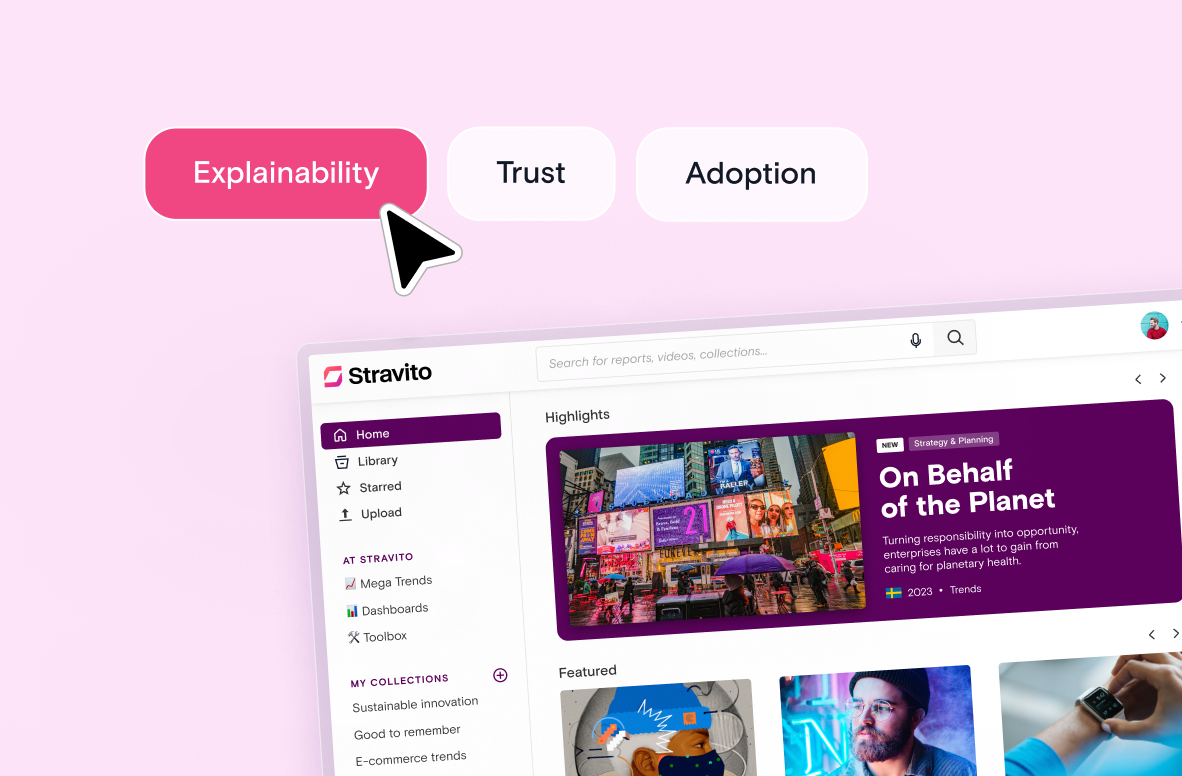Most enterprises aren’t struggling to gather customer insights. They’re struggling to use them.
Despite all the surveys, interviews, dashboards, and feedback forms, too many valuable insights end up buried in folders, disconnected from strategy, and forgotten before they can have a real impact.
The result? Missed opportunities, slower decisions, and duplicated research that cost both time and trust.
If you want to gain customer insights that actually drive change, you need more than data collection—you need a system for activation. This guide breaks down how.
If you’re short on time, here are the key takeaways:
- Customer insights ≠ raw feedback. True insights reveal patterns, motivations, and opportunities for action—far beyond what any one survey or comment can show.
- Collection alone isn’t enough. The best way to gain customer insights is to connect qualitative and quantitative data, synthesize them, and make the results usable.
- Common missteps hold teams back. Treating feedback as insight, over-collecting data, or storing research in silos all weaken your return on investment (ROI).
- Activation is where the value is. To gain a competitive advantage on customer insights, you need tools that simplify access, encourage reuse, and show measurable impact.
Ready to stop stockpiling data and start making it count? Let’s begin where the gap usually starts: collecting more without changing more.
What is a customer insight (and what isn't)?
Everyone talks about customer insights, but not everyone means the same thing.
In enterprise organizations, it’s easy to conflate data, feedback, and insight. But understanding the difference is critical if you want your research to do more than check a box.
Insights vs. observations vs. data
Let’s break it down:
- Data is the raw input—click rates, NPS scores, social shares, transaction history. It tells you what happened.
- Observations describe patterns, such as noticing that customers abandon their carts at checkout or that complaints spike after new features are launched.
- Insights explain the why. They connect behavior to motivation and context—why customers abandon, what they expected, what pain points they’re trying to solve.
💡 In short: Data informs. Observations describe. Insights explain.
The best customer insights are grounded in evidence but go beyond the obvious. They reveal unmet needs, emotional drivers, or systemic blockers that teams can act on.
What makes an insight “actionable”?
For customer insight to actually drive change, it must meet two criteria:
- It prompts action.
An insight should help you make a clearer decision, whether that’s refining a product, improving the customer journey, or targeting the right audience more effectively.
- It’s human-centric.
The most valuable customer insights are rooted in real-world needs, not just stats. They speak to emotions, expectations, and lived experience, not just trends in a spreadsheet.
True customer insights focus on consumer centricity, emphasizing real-world needs and emotional connections rather than just raw data.
For example:
- “Our NPS score dropped” is data.
- “Customers are frustrated with long wait times during onboarding” is an observation.
- “New customers expect faster onboarding because they’re comparing us to best-in-class SaaS experiences. Our current workflow feels clunky and outdated” is an insight.
Let’s look at how to consistently generate insights that teams trust, use, and rally around.
Six techniques to gain customer insight
To truly understand your customers and gain meaningful insights, it’s essential to employ a combination of methods that capture diverse perspectives and data types. Here are six proven techniques that help you gather rich, actionable customer insight:
- Customer interviews
Deep, one-on-one conversations that uncover motivations, emotions, and unmet needs.
- Customer surveys
Structured questionnaires that collect quantitative feedback from a broad audience.
- Focus groups
Interactive sessions where group dynamics reveal perceptions, preferences, and pain points.
- Behavioral data analysis
Tracking how customers interact with your products, services, and touchpoints.
- Social media analytics
Monitoring real-time conversations and sentiment across platforms to capture unfiltered feedback.
- Competitor reviews
Studying competitor offerings and customer feedback to identify gaps and opportunities.
Using these techniques in combination enables you to collect diverse and complementary customer insights that inform smarter decisions.
These six techniques provide a strong foundation for gathering customer insights, but collecting data is just the beginning.
To turn these insights into real business impact, you need a clear, structured process.
That’s where our five-step framework comes in.
It's designed to help you ask the right questions, synthesize information, and activate insights across your organization.
The 5-step framework for gaining customer insights that drive change
Gaining customer insights isn’t just about collecting more data. It’s about asking the right questions, using diverse methods, and turning findings into decisions that move the business forward.
Here’s a practical, five-step framework to guide your process, plus how Stravito can help you make each step easier and more effective.
Step 1: Set clear business questions
Start with the decision you need to make. What business problem are you solving? Without clear objectives, your insight efforts risk becoming unfocused and overwhelming.
Ask yourself:
- What do we need to decide?
- What outcomes will success look like?
- Which parts of the customer journey or experience are most critical?
Align your insight objectives with these goals to ensure your research is relevant and actionable.
How Stravito helps:
Stravito’s platform enables you to tag insights by business question or objective, keeping research aligned with strategic priorities and making it easy to find insights that inform key decisions.
Step 2: Use diverse collection methods
No single source gives the full picture. Combine qualitative, quantitative, and behavioral data to gain a well-rounded understanding.
Use a mix of:
- Direct feedback: customer surveys, interviews, focus groups
- Indirect signals: web analytics, social media listening, online reviews
This diversity ensures you capture both what customers say and what they actually do.
How Stravito helps:
Stravito supports aggregation of insights from all formats and sources, centralizing your scattered data and feedback into one searchable hub.
Step 3: Curate, synthesize, and contextualize
More data doesn’t always mean more value. Without curation, you risk ‘insights inflation’. That means too much information that overwhelms decision-makers instead of helping them.
Organize your insights by tagging, clustering related themes, and summarizing key takeaways. Highlight what truly matters and why.
How Stravito helps:
Stravito’s AI Assistant distills large volumes of research into clear summaries and “so what” statements, helping your team focus on meaningful, actionable insights.
Step 4: Democratize access to insights
Insights locked in decks or shared only within research teams aren’t insights at all; they’re missed opportunities.
Put your findings in the hands of marketing, customer experience, product, and other teams who can act on them. Avoid siloed storage like SharePoint or email chains.
How Stravito helps:
Stravito organizes collections by theme, persona, or campaign, making it easy for cross-functional teams to discover and apply insights when and where they need them.
Step 5: Measure the impact of insights
Insights are only valuable if they lead to action. Track how insights influence decisions, product changes, or marketing campaigns.
Define KPIs such as:
- Actions taken based on insights
- Time from insight discovery to decision
- Frequency of insight reuse across teams
How Stravito helps:
Stravito’s usage tracking and insights feed provide transparency on how insights are used, helping you prove ROI and refine your research strategy.
Following this framework gives you a clear roadmap for gaining and activating customer insights.
But if you’re looking for practical steps to start making progress today, here are some quick wins you can implement immediately to boost your insight efforts and deliver faster impact...
Quick wins for gaining and activating customer insights today
If you want to start seeing real impact from your customer insights right now, these practical quick wins will help you gather, apply, and leverage insights more effectively, without waiting for a big project or platform overhaul.
1. Audit your existing customer feedback sources
Start by mapping where your organization collects customer feedback and data related to customer interactions.
By centralizing your customer and market insights, you unlock the benefits of a single platform that improves collaboration and insight reuse across teams.
This includes customer surveys, customer feedback forms, online reviews, social media analytics, customer interviews, Net Promoter Score data, and behavioral data from Google Analytics or CRM systems.
By identifying overlapping sources and gaps in your customer feedback, you can avoid duplicated research efforts and focus on collecting more valuable customer insights that truly reflect your customer base and target audience.
2. Set one clear business question per insight initiative
Avoid the trap of collecting all the data without purpose.
Align every insight effort with a specific marketing strategy or business goal, such as improving customer satisfaction or understanding pain points in the customer journey.
Clear objectives help your marketing team analyze data and derive meaningful insights that can be applied directly to marketing campaigns, product development, or customer experience improvements.
3. Use simple tagging and categorization to organize insights
Whether you’re working with qualitative insights from focus groups and customer interviews or quantitative data from surveys and behavioral tracking, organizing this information is critical.
Use categories like customer segments, product lines, or marketing initiatives to tag insights. This makes it easier for cross-functional teams, like sales efforts, customer success teams, and product managers, to find and use relevant insights when making decisions.
4. Regularly share insight summaries with stakeholders
Make it a habit to create concise reports or newsletters that highlight key customer sentiment, competitor reviews, and valuable insights uncovered from your research.
Sharing these insights helps encourage more insights-driven conversations and aligns teams around your customer’s perspective and evolving expectations.
5. Leverage quick-win analytics tools
Don’t wait for large-scale studies to start using data. Use Google Analytics, net promoter score dashboards, and social media analytics to gather consumer insights in real time.
This behavioral data allows your marketing team to spot trends, monitor customer satisfaction, and react faster to negative feedback or emerging pain points.
6. Encourage frontline teams to report customer pain points
Your customer success teams and sales efforts interact with your customers daily and have firsthand knowledge of customer frustrations and desires.
Establish a simple feedback loop to capture their insights and integrate this qualitative feedback into your broader insight ecosystem.
7. Start measuring insight impact now
Begin tracking how insights are being used—whether that’s measuring how often reports are accessed, how insights influence marketing initiatives, or how they affect customer loyalty and business growth.
While these quick wins can jumpstart your insight efforts, it’s just as important to avoid common pitfalls that can undermine your progress.
Let’s look at some frequent mistakes teams make, and how to fix them, so your customer insights don’t just accumulate but truly drive business impact.
Common mistakes (and how to fix them)
Even with the best intentions, teams often trip up when turning customer feedback into actionable insights. Avoiding these pitfalls can make the difference between research that drives change and research that collects dust.
Treating feedback as insight
Customer feedback is invaluable, but raw feedback alone isn’t insight. Individual comments or survey results must be analyzed, contextualized, and validated against trusted sources before they can inform decisions.
Relying on isolated feedback risks chasing anecdotal issues or surface-level complaints without understanding root causes or patterns. Instead, synthesize feedback with other data points, such as market research, behavioral data, and competitor analysis.
How to fix it: Use a structured process to combine multiple inputs and confirm findings before labeling them as insights. This ensures your team focuses on meaningful, validated insights rather than isolated opinions.
Letting research live in decks only
Insights locked away in PowerPoint decks or PDFs rarely get seen or used outside the immediate research team. This creates silos and duplication of effort.
How to fix it: Democratize your insights by sharing them in accessible platforms where marketing, product, and CX teams can find and apply them anytime. Avoid SharePoint or email traps.
Focusing only on collection, not activation
Many teams focus on gathering more data without a clear plan for applying it. This leads to insight overload and frustration when no clear decisions emerge.
How to fix it: Prioritize insight activation by defining success metrics, tracking usage, and linking insights directly to business decisions.
Avoiding these common mistakes sets the foundation for insights to truly influence your business. But what does this look like in action?
Let’s explore a real-world example of how a global brand transformed scattered research into strategic impact.
Case study snapshot: a global brand reducing insight waste
A leading multinational brewer was sitting on a goldmine of customer and market insights — but accessing and applying that knowledge was a constant challenge.
Research reports, competitor analyses, and customer feedback were scattered across multiple departments and systems, creating silos and slowing down decision-making.
Before Stravito: Teams spent excessive time searching through disconnected reports and files, often duplicating research that had already been done elsewhere.
After adopting Stravito: The company centralized all customer and market insights into one user-friendly platform accessible across global teams, dramatically reducing search time by 70% with AI-powered search.
Before Stravito: Marketing, product, and insights teams struggled to share learnings efficiently, leading to inconsistent strategies and missed opportunities to respond to customer needs.
After adopting Stravito: Cross-functional collaboration improved, with marketing, product, and customer experience teams aligning around shared, actionable insights organized by theme, region, and business objective.
Before Stravito: Valuable customer experience insights weren’t reaching the right people at the right time, delaying product improvements and campaign optimizations.
After adopting Stravito: Insights, information became easily accessible and timely, enabling faster decision-making, improved campaign optimization, and stronger customer-centric strategies.
Additionally, the platform’s usage tracking and analytics helped prove research ROI and informed ongoing investment decisions, resulting in a 254% return on investment over three years, driven by reduced duplication and faster, data-driven decisions.
This example shows how a centralized, accessible insights platform can transform scattered research into a strategic advantage.
Want to see more examples of impact?
Explore our full collection of customer case studies to learn how enterprise teams unlock insight-driven success.
Now, let’s explore exactly how Stravito helps you go from insight to impact by empowering your teams to work smarter, faster, and together.
How Stravito helps you go from insight to impact
Stravito is designed to empower insights, marketing, product, and customer experience teams to work smarter and together. It’s not just a place to store research; it’s a platform that makes insights discoverable, digestible, and actionable across your organization.
Unified knowledge hub
Centralize all your customer, market, and competitor insights in one intuitive platform. Stravito supports ingestion from a wide range of sources—surveys, interviews, analytics, third-party reports—so you’re never hunting across silos again.
AI-powered discovery and synthesis
Stravito’s AI Assistant leverages generative AI to distill large volumes of data into clear summaries, enabling your team to focus on meaningful and actionable insights.
It can surface contradictions, spot trends, and help you ask better questions, saving time and boosting insight quality.
Built for non-researchers
Your marketing, product, and CX teams don’t need to be research experts to find and use insights. Stravito’s simple search, curated collections, and thematic tagging make it easy for anyone to quickly discover relevant knowledge.
Out-of-the-box deployment
Get started fast without lengthy IT projects. Stravito integrates seamlessly with your existing tech stack and scales with your organization, whether you’re centralized or decentralized.
Insight-impact tracking
See how insights are used with detailed analytics. Understand what’s driving decisions and where gaps remain, so you can continuously improve your research investment.
Ready to turn your customer insights into business results?
Request a demo today and see how Stravito can help you close the insight activation gap.
FAQs
What’s the best way to gain customer insights at scale?
Combine qualitative methods, such as interviews and focus groups, with quantitative data, including surveys and behavioral analytics. Using a platform like Stravito helps centralize and manage this information, making gaining customer insights more efficient and actionable.
How do I turn customer feedback into actionable insights?
Analyze and synthesize customer feedback surveys, online reviews, and behavioral data to uncover patterns and pain points. AI-assisted tools can help apply these customer insights to enhance marketing campaigns and improve the overall customer experience.
What’s the difference between market research and customer insight?
Market research collects broad consumer data, while customer insight reveals the motivations and emotions behind that data, offering a deeper understanding of customer needs and expectations.
How can I make insights more visible to other teams?
Use a centralized platform to democratize customer insights, enabling marketing, product, and customer success teams to easily find and apply relevant knowledge, boosting collaboration and decision-making.
What tools help manage customer insights more effectively?
Platforms with AI-powered search and curation capabilities, such as Stravito, help collect, analyze, and organize customer insights from multiple sources, including surveys, Google Analytics, and Net Promoter Score data, driving faster, data-driven decisions.




